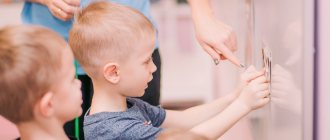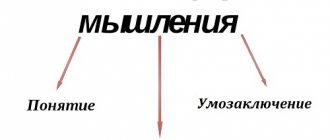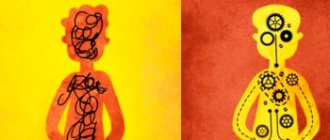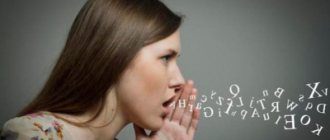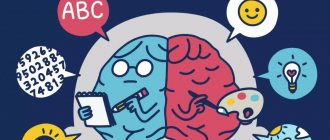Author's rating
Author of the article
Smirnova Olga Leonidovna
Neurologist, education: First Moscow State Medical University named after I.M. Sechenov. Work experience 20 years.
Articles written
94
A person constantly creates a model of the world in his consciousness, during which the brain is active and takes forms called visual-effective or figurative thinking. Science gives its own explanation for this: this is the main type of human thought processes since the times of primitive society, the peculiarity of which is that it is associated with solving practical problems. Thanks to this type of thinking, a person realizes the need to perform some action, for example, buy groceries or do exercises.
Everyone develops their own picture (or model) of the world. Thanks to the activity of brain cells, a person gains knowledge about the world around him and his existence. He carries out practical activities to change reality, using visual and effective thinking.
A person’s thinking ability, as it develops, goes through three stages, on which the type of thinking depends:
- Visually effective.
- Visual-figurative.
- Verbal-logical.
Effective helps to solve necessary tasks with the help of hands (touching an object): take, move, build, pour out, break, etc. It is especially important for infants and older children (1-3 years) to improve fine motor skills of their fingers. This has a connection with the formation of consciousness. Therefore, the first stage in development is to launch visual and effective thinking.
This type is considered the main one and is actively used by children. These are movements without the participation of speech; they are performed with the help of actions in relation to objects that are currently in the baby’s field of vision.
The type of thinking in different sources has the following definitions: elementary, basic, simplest, lowest. Its signs are noticeable even in animals.
The peculiarity is the close connection of thought processes with the actions performed. A child, repeatedly playing with the same object, gradually reveals its internal characteristics and features. A little person develops skills by acting “by example.” Thus, an object in the hands of a baby is a way of understanding the world around him.
The concept of visually effective thinking
For example, the short psychological dictionary “Phoenix” of 1998, the authors of which are L. A. Karpenko, A. V. Petrovsky and M. G. Yaroshevsky, gives the following definition: visual - effective thinking - is one of the types of thinking that characterizes solution of a certain problem , but this occurs due to a physical change in a certain situation, in other words, due to a real transformation. A child is a prime example of this. For him, visual—effective thinking is the first stage of thinking (development).
Another characteristic of visually effective thinking is given by the dictionary of practical psychologist “Harvest”, published by S.Yu. Golovin, 1998: this type of thinking is a special form of thinking. We can observe both its elementary properties and more complex ones. A more complex form is the creation of a certain internal human space, where the relationships between subjects are quite schematized.
V.M. Gordon gave the following characteristics of visually effective thinking: its characteristic feature is the solution of a non-standard problem by observing real objects . As well as their mutual interaction and various material changes, the main participant of which is the subject himself. In his opinion, this type of thinking is nothing more than the simplest form of thinking: the elementary form of its manifestation.
All these definitions, given by different scientists, are somewhat different from each other, however, they all have one characteristic feature in common: the adoption of a solution to a problem through conscious human action.
Visually - effective thinking - human mental activity
Thanks to the activation of brain activity, a person has the opportunity to understand the world around him and carry out certain actions in it. In the human mind there is a continuous process of creating a certain model of the world. It is worth noting that during this activity the brain can take several forms. It is they who are characterized as visually effective and figurative.
Since ancient times, mental activity has its origins in visual and effective thinking. It is responsible for solving practical problems. For example, with its help a person understands that he needs to build a house or cook dinner.
In general, there are three main types:
- visually - figuratively
- clearly - effective
- verbal - logical
Developmental tasks for preschoolers on logical thinking
If in early preschool age visual and figurative thinking is dominant, then older children on the threshold of schooling should rely on logic in their conclusions. It
is also important to justify all your decisions verbally. Therefore, this type of thinking has another name - verbal
Effective techniques that develop verbal logical thinking in older preschoolers include didactic games and exercises.
Association games
Verbal games for building an associative series are perceived with interest by preschoolers, as they are based on images. Children imagine what is behind the proposed concept and come up with words related to this concept.
1.Who will praise best? Children are asked to come up with as many characteristics as possible for one object. You can add a competitive nature to this game.
2. Identify the owner. Children are given one or two striking signs, on the basis of which they determine a holistic image.
- tail and ears
- pen
- spines
- sheet
- lid
3.Free associations. Instructions: “What image or sign do you remember when you hear this word?” Several people can take part in the game. The first names any word, the second names its association with it, the third names the quality or concept associated with the previous word. Sometimes you can clarify why exactly this association arose in a preschooler.
Logical reasoning exercises
1.Complete tasks using visual material. Children are offered pictures with images where they have to identify an extra object, pick up a missing one, or insert a missing figure into its place.
The preschooler not only finds a solution, but also explains his choice and verbalizes his reasoning.
2. Tricky lotto. Prepare two identical sets of pictures. Children play in pairs, each participant receives their own set.
One of the participants chooses one picture at his discretion and, without showing it, describes the image, highlighting the main features. The second participant guesses and then offers his description of another picture.
3. Guess it! Participation of four or more children is desirable. Preschoolers form two subgroups. One of them agrees on what object to wish for. Participants in the second subgroup, in order to guess the object, ask questions that can only be answered in monosyllables - “yes” or “no.”
The task is not only to guess, but also to be able to identify important signs. Having received the answer, the subgroups change roles.
Games for the development of conceptual apparatus
1. Help out the alien. Children really love this game, in which it is assumed that they have met an inhabitant of another planet who knows nothing about our world. Typically, one child plays the role of an alien and asks questions:
- What is this?
- What is this item for?
- How to use it?
One or two preschoolers answer questions from an inquisitive guest. The game well develops verbal logical thinking, as well as coherent speech.
2. Does this happen or not? Instructions: “Make a true and false judgment using the given words.” Prepare a few pairs of words for the game.
For example, a tree - roots. True proposition: “Every tree has roots.” False: “leaves grow on the roots of the tree.”
3. Because... Instructions: “Come up with at least three explanations for the same event (phenomenon, fact).” Example: The flowers bloomed because...
- …spring has come
- ...they were watered on time
- ...even the flowers wanted to please Masha
Such game exercises develop mental operations, the ability to establish cause-and-effect relationships, and the ability to formulate judgments and inferences.
Main stages of formation
Psychologists give the following definition of visually effective thinking: this is nothing more than practical activity to change the reality around us, the implementation of which occurs through the interaction of objects with real objects.
Interesting fact: visual-effective thinking is the main activity of babies . This is visible from birth and continues until the age of three. Next, the child performs certain actions with objects and gradually learns to think. A child explores the world around us tactilely, that is, touching everything. Of course, there are some incidents: they break toys, but this is precisely the first step towards research activities and awareness of the reality that surrounds us.
The main feature of the child’s thought process is the fact that the child, in order to solve any, even the most primitive problem, begins to take active action. The same cannot be said about an adult. He passes the essence of the problem through his own consciousness. There are many examples of such behavior. Here is one of them: the child needs to get this or that object, but it is impossible to reach it, since the object is located on the highest shelf of the cabinet. A child aged 2-3 years will use a chair .
At an older age, at about 5 years old, the ability to form a preliminary picture in one’s consciousness and analyze the result of one’s actions comes. That is, a 5-6 year old child will think: “Won’t he fall?” Thus, another type of thinking is formed: figurative.
Why is it important to develop creative thinking?
The very concept of “image” means the imprinting of objects and phenomena of the real world in human consciousness, the formation of an imaginary appearance.
A preschooler, especially an older one, is already able to accumulate a sufficient number of such reflections. Moreover, sometimes they are not visual, but tactile or audio in nature.
The skill of imaginative thinking greatly simplifies a child’s interaction with the outside world. To solve a given problem, he just needs to imagine all its components and find the answer.
In the future, properly developed imaginative thinking will make it easier to master spatial thinking and imagine the world in three-dimensional display.
It is especially important to pay attention to the child at the stage of development of imaginative thinking for the following reasons:
- The ability to operate with images significantly speeds up the solution of first everyday, and later logical and mathematical problems.
- The ability to think in images forms the aesthetic component of the personality and the craving for beauty, which intensifies as one grows older.
- Operating with images contributes to the development of creative thinking.
Formation of thinking in childhood
Let's figure it out: how does the formation of thinking in children occur? Of course, thanks to games and communication with adults. The baby’s thought process goes through the following stages:
- Effective. It is characterized by solving simple problems through the manipulation of objects. That is, thanks to his hands, the child develops his fine motor skills and, consequently, his thinking itself.
- Figurative. A feature of this thinking is a more complex process: the child learns to create in his imagination the consequences of actions taken. This type of mental activity is one of the most significant, as it plays a huge role in a child’s education (at school, college, etc.)
- Verbal - logical. This is the highest form of thought process. Here the child learns not just to think, but to think in certain concepts. They are expressed using words. For a child, a word is a specific association with a previously familiar object. That is, by the word “dog” the child understands a specific dog; after time, the child develops the ability to generalize objects.
mental activity in a child from a very early age . There are recommendations for different ages that should be followed:
- Before the child is one year old, you need to teach him to play using ropes. For example, to get a toy that is in his field of vision, you just need to pull the rope, which should be tied in advance. Thus, the child learns not to immediately grab an object, but to reach it with the help of another device.
- As soon as the child starts to get up and starts throwing all the toys out of the crib, you can do the following: tie all the toys with ropes to the side of the crib. The baby will understand that when throwing them out, they do not fall. It will be fun and educational for him to pull the ropes, thereby returning the toys to the crib.
- From the age when the baby gets used to sitting, you can try to play this game with him: put interesting toys near him and tie a ribbon to each of them. You give all the ends of the ribbons into his hands, he will, if desired, pull the ribbon that is tied to the toy he likes.
From all of the above, we can draw the following conclusion: visually - effective thinking - is practical in nature .
For the full development of the child, it is in your interests to come up with a variety of games, thanks to which the child will learn to use a foreign object to achieve a goal.
Diagnostic and study methods
Characteristics of levels, starting with objective perception
A child receives his first impressions of the world around him after birth. Gradually, his worldview is replenished with new sensations and images (read more about what imaginative thinking is, why it is needed, and from this article you will learn why you need to improve this way of thinking in adults and children).
The thinking of a little person consists of the concept of the properties of an object, comparing data, searching for differences, and obtaining new sensations. His parents help him in this, sharing their knowledge, teaching and educating him. With the ability to move independently, the baby expands his capabilities in exploring the world, adding new images to it. The child analyzes and systematizes the entire stock of information, creating his own picture of the world.
Closer to one year, the baby, through practical actions, trial and error, receives new information and learns the properties of objects. From one to two years - combines and operates with objects. At the same time:
- learns to understand speech;
- develops memory;
- auditory and visual perception.
By 3 years old the baby:
- significantly increases memory capacity;
- improves speech;
- learns to solve practical problems using the information received.
Manifestation of pathological variants and their correction
Attention. In children with mental disabilities, sensorimotor thinking is characterized by a lag. They do not have the skill of generalizing their experience in actions with everyday objects. Without the help of an adult, they are not able to analyze and discard erroneous options, thereby not being able to achieve their goal.
“Special” children do not have the need to connect action with speech, which indicates that their manipulations are not conscious. This is a feature of the development of oligophrenics and autists. Timely correction of these pathologies gives good results.
In adults, serious violations can manifest themselves in a rollback to the visual-effective period of thinking. Characterized by obsessive repetitive movements and manipulation of objects. It appears in schizophrenics and catatonics.
Examples of practical diagnostic methods: how is it possible using cubes and other methods?
With the help of diagnostics, specialists are able to determine the integrity of a child’s intelligence. Some techniques are:
- "Pyramid addition" . The inspector shows the child the pyramid and asks him to disassemble it, then assemble it, taking into account the size of the rings. If the subject does not understand it, the experimenter shows how to do it and asks the child to repeat his actions. If the child does something wrong, they do not stop him; they explain his mistakes and ask him to redo it. Instead of a pyramid, you can build towers from cubes or objects from a constructor.
- Seguin board" is a board with recesses for different figures. The difficulty depends on the age of the subject. Older children are offered boards where the inserts consist of several parts. The psychologist shows the child the assembled board, then pours out the contents and offers to assemble it.
- “Get the cart” - a cart with a ring through which a rope is threaded is placed on the table. The child’s task is to pull the cart towards him by folding both ends of the rope. Adults don't show you how to do things right. If the rope slips, it is corrected out of sight of the person being tested. Suitable for children aged 4-5 years.
There are quite a few similar research methods. Each psychologist himself selects the closest and most informative diagnostic method to him.
The role of thinking in adulthood
Many people believe that in adulthood, visually effective thinking becomes irrelevant. However, it is not. An adult, without noticing it, actively uses a form of brain activity.
Vivid examples of this are more complex processes in the human brain : the ability to understand the principles of operation of the latest equipment, the ability to come up with an interesting interior for a room. That is, everything that presupposes a certain result of work. It is especially evident in the following areas of activity: engineering, mechanics, various repair and construction work.
1.2. Physiological basis of thinking
Like all mental processes, thinking is an activity of the brain.
The physiological basis of thinking is temporary nerve connections (conditioned reflexes), which are formed in the cerebral cortex. These conditioned reflexes arise under the influence of second signals (words, thoughts), reflecting reality, but they necessarily arise on the basis of the first signal system (sensations, perceptions, ideas).
I.P. Pavlov wrote that “kinesthetic stimuli coming to the cortex from the speech organs are second signals, signals of signals. They represent an abstraction from reality and allow for generalization, which constitutes our superfluous, specifically human, higher thinking...”
That is, the physiological basis of thinking is brain processes at a higher level than those that serve as the basis for more elementary mental processes, such as sensation. However, at present there is no consensus on the significance and order of interaction of all physiological structures that support the thinking process. It is undeniable that the frontal lobes of the brain play a significant role in mental activity as one of the options for purposeful activity. In addition, there is no doubt about the importance of those areas of the cerebral cortex that provide gnostic (cognitive) functions of thinking. There is no doubt that the speech centers of the cerebral cortex are also involved in ensuring the thought process.
Unlike sensations, perceptions and memory, second-signal connections are more complex systems that reflect various relationships between objects and phenomena.
In thinking processes, both signaling systems are closely related to each other. The second signaling system allows for unlimited orientation in the surrounding world; through it, “the highest human adaptation - science” is created.
But the second signaling system relies on the first. If words are deprived of a certain real meaning for a person, if a person cannot correlate them with some specific objects and phenomena, then such words cease to be signals of reality. Thinking proceeds normally only with the participation of both signaling systems, but the leading role remains with the second signaling system, since the word is a signal richer in content and is associated with the processes of abstraction and generalization.
The complexity of studying the physiological foundations of thinking is explained by the fact that in practice thinking as a separate mental process does not exist. Thinking is present in all other cognitive mental processes, including perception, attention, imagination, memory, and speech. All higher forms of these processes, to a certain extent, depending on the level of their development, are associated with thinking.
Thus, thinking is a complex analytical and synthetic activity carried out by the joint work of both signaling systems. Moreover, since thinking is a reflection of reality generalized using a word, the second signaling system plays a leading role in this activity. Constant and close interaction with the first signaling system determines the inextricable connection of the generalized reflection of reality, which is thinking, with sensory knowledge of the objective world through sensations, perceptions, ideas.
How to train logical thinking in children
To train children so that the development of logic begins as early as possible, educational games and exercises will be relevant. They will help to understand cause-and-effect relationships, classification, and generalization. These include tasks about animals and their habitat, surrounding objects and their purpose, grouping of objects, comparison based on elementary characteristics: size, color, shape.
“Where is whose mother?”
A lotto-type task involves selecting cards with images of animals and their cubs familiar to children. An adult invites the child to look at pictures depicting a chicken, a cat, a dog, a cow, a horse, a goat, or a bear. Then, among other cards, find those on which the cubs of these animals are drawn, and connect them together. Ask how to name the baby correctly, if the baby finds it difficult, be sure to say all the names. Elementary judgments in children will help raise questions about who will grow up from a chicken, a puppy, or a kid. To maintain interest in the task, read funny rhymes:
The cow has a son, a calf, a very polite child. Mom teaches baby to eat grass slowly.
And the hen's chickens all look alike. Both girls and boys are like dandelions.
Stupid little goat! He butts everyone from the cradle. What should we do when his horns grow?
“Who can say, who knows when this happens?”
The game helps develop logic, trace cause-and-effect relationships between natural objects, and enriches speech with reasoning. The child is shown a series of plot pictures depicting the seasons and is asked to arrange them according to the signs, for example:
- Snowdrifts; children and adults are dressed warmly; guys sledding; snowing.
- Drops, streams; boys launch boats; the first snowdrops among the snow.
- The sun shines brightly; children swim in the river; adults and kids play ball.
- It's raining, cloudy sky; birds fly in a caravan; Mushroom pickers come with baskets.
Having worked with the cards with the child, the adult asks when these phenomena occur in nature. Teaches the child to correctly generalize a series and talk about the changing seasons. It’s interesting to reinforce the conversation with riddles:
The streams rang and the rooks flew in. Who can say, who knows when this happens?
The long-awaited time! The kids shout: Hurray! What kind of joy is this? It's (summer).
The days have become shorter, the nights have become longer, Who can say, who knows, When this happens?
It stings your ears, stings your nose, The frost creeps into your felt boots. Who can say, who knows, When this happens?
"Logical chains"
Such tasks are usually offered to children of middle and senior preschool age who have experience in generalizing subjects. However, with fairly simple game material, you can begin teaching logical operations (classification and generalization) at a young age. The child makes chains of objects from a certain group, for example, flowers, vegetables, fruits. If the child finds it difficult, the parent helps to name a group of objects with a generalizing word. The task can be made more difficult by asking you to find one among a group of pictures that complements the already constructed chain.
“I’m starting, you continue...”
A classic game that is offered to children of all ages to develop logic and analytical skills. In each age group, tasks will vary in difficulty. Kids are given simple and accessible word combinations. The adult begins the phrase, the child continues:
- Sugar is sweet and lemon is sour.
- The bird flies and the turtle (crawls).
- The elephant is big, and the bunny is small.
- The tree is tall and the bush is low.
Playing with a ball will help maintain your child's interest in the task. The adult throws the ball with the beginning of the phrase, the child returns it with the ending. For older preschoolers, complex tasks that require inference are selected:
- The table is higher than the chair, which means the chair is (below the table).
- After night comes morning, which means morning (after night).
- Stone is heavier than paper, which means paper is lighter than stone.
“What’s extra?”
A logical task, accessible to all children, well develops the ability to generalize, compare, and classify. The adult invites the child, among the pictures depicting objects of a certain group, to find the extra one (an object from a different group). For example, among the vegetables there is a picture of a fruit, among the pieces of furniture there is a card with clothes.
Creative thinking
Parents believe that the tasks of mental education of preschoolers are to teach the child to count and write in block letters. But this is not enough for successful schooling. The child must learn to think creatively. At school he will not only have to solve examples and write dictations. In both junior and senior grades, many assignments will be of a creative nature. Diagnostics of the mental development of preschoolers shows that children with a rich imagination cope well with both writing essays and solving algebra problems.
The development of creative thinking begins at 3-4 years. The exercises used by parents or educators should be in the form of a game. If activities for developing imagination take the form of a lesson at school, the result will not be achieved. Children quickly get tired of such exercises. In order for classes to be successful, it is necessary to take into account the thinking characteristics of preschool children.
The baby’s imagination needs to be constantly stimulated. Developing creative thinking is a good activity while walking through the autumn park. You can invite children to compose a fairy tale about fallen leaves. At home, you need to stage a play created by a children's writer or by the child himself. You should involve your son or daughter’s friends and their parents in the game. Such methods of mental education will lead to quick results and will captivate the child.
At the age of 6-7 years the task should become more difficult. We need to prepare for school, learn to work with pencils and pens. It is necessary to take into account the peculiarities of the development of thinking in children at this age. The preschooler wants to express his thoughts graphically. The simplest task involves writing on a piece of paper several words that are not related in meaning, for example, tree, pen, cake, boots. The child should write a short essay containing all the words listed. You can draw lines, dots or any abstract shapes on a piece of paper and invite the preschooler to complete the drawing of the objects.
Forming logic in children from two to seven years old
During this period, the baby continues to improve his conversation skills. The child already has a good imagination. To imagine what is happening in a fairy tale or book, he no longer needs to use pictures.
The most effective exercise for developing logic at this age is discussing a book. This should be done immediately after you have read it.
You can ask your child:
- Retell what you read.
- Answer the questions. Ask him about certain situations, let him explain why they happened. And what would have happened if these events had not happened.
- Dream up. Invite him to come up with different options for developing the plot. Let him say what would have happened if a particular character had acted differently. And how this would affect the main plot.
At this age, the child is already oriented in time. He distinguishes between what is the past and what is the future. With the help of this knowledge, the child will be able to understand what cause-and-effect relationships are. But only if you explain this to him with an example.
Tell your child that every action has a reason. And that people act a certain way not because they are good or bad. And because they were forced to do this by a specific situation.
But in the period from two to seven years there is one minus. A child’s thinking at this age is not well developed. He cannot yet show empathy (sympathize) and put himself in other people’s shoes. A child can perceive a certain event only based on his life experience.
If you want to develop empathy in your child, we recommend that you spend as much time as possible on this issue. Start playing with your child and simulate different situations. In them, the baby must play the role of another person. And learn to adapt to the situation that arises, experiencing the emotions that the person they are “playing” would experience.
Between two and seven years of age, a child can already solve some problems. But when he does this, it is not based on logic. And he acts by intuition. And that's bad.
Let's look at it with an example. Take 20 cubes and arrange them into two piles of 10 pieces each. Place one of them evenly on the floor, and pile the second on top of each other. And give the child the task of deciding which one is bigger. Most likely, he will choose those cubes that are piled up. Because from the outside it seems that there are more of them due to their size.
Also, you can use various educational printed materials. They are usually published in children's magazines.



